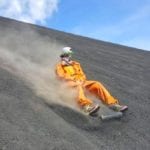 Creepy
Creepy  Creepy
Creepy  Technology
Technology 10 Scientific Breakthroughs of 2025 That’ll Change Everything
 Our World
Our World 10 Ways Icelandic Culture Makes Other Countries Look Boring
 Misconceptions
Misconceptions 10 Common Misconceptions About the Victorian Era
 Mysteries
Mysteries 10 Strange Unexplained Mysteries of 2025
 Miscellaneous
Miscellaneous 10 of History’s Most Bell-Ringing Finishing Moves
 History
History 10 Great Escapes That Ended Right Back in Captivity
 Weird Stuff
Weird Stuff 10 Fascinating Things You Might Not Know About Spiders
 Food
Food 10 Everyday Foods You Didn’t Know Were Invented by the U.S. Military
 History
History 10 Odd Things Colonial Americans Kept at Home
 Creepy
Creepy 10 More Representations of Death from Myth, Legend, and Folktale
 Technology
Technology 10 Scientific Breakthroughs of 2025 That’ll Change Everything
 Our World
Our World 10 Ways Icelandic Culture Makes Other Countries Look Boring
Who's Behind Listverse?

Jamie Frater
Head Editor
Jamie founded Listverse due to an insatiable desire to share fascinating, obscure, and bizarre facts. He has been a guest speaker on numerous national radio and television stations and is a five time published author.
More About Us Misconceptions
Misconceptions 10 Common Misconceptions About the Victorian Era
 Mysteries
Mysteries 10 Strange Unexplained Mysteries of 2025
 Miscellaneous
Miscellaneous 10 of History’s Most Bell-Ringing Finishing Moves
 History
History 10 Great Escapes That Ended Right Back in Captivity
 Weird Stuff
Weird Stuff 10 Fascinating Things You Might Not Know About Spiders
 Food
Food 10 Everyday Foods You Didn’t Know Were Invented by the U.S. Military
 History
History 10 Odd Things Colonial Americans Kept at Home
10 Astounding Facts About Extremely Low Temperatures
Over the past 150 years, scientists have developed a number of methods for reaching extremely low temperatures. Fluids like liquid nitrogen and liquid helium, both of which have significantly low boiling points, have been put to use across numerous fields. More recently, laser cooling techniques have also been deployed.
These methods have given rise to all kinds of supercool new discoveries and inventions. From a levitating magnetic railway system and ultrasmooth novelty ice cream to state-of-the-art medical scanners, lunar cold traps, and so much more, extreme cold is proving essential for the next wave of scientific developments.
10 Superconductors And Levitating Trains
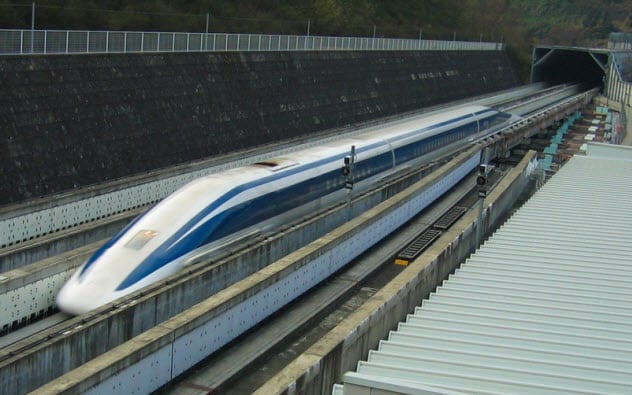
In 1911, when scientists were first experimenting with extreme cooling techniques, Dutch physicist Heike Kamerlingh Onnes discovered something remarkable about the way that certain materials conduct electricity. He observed that simple elements like mercury can conduct electricity with zero resistance once the temperature drops below a specific threshold.
At low temperatures, these materials become perfect conductors of electricity—hence the name “superconductors.” In a closed loop of superconducting material, an electrical current would be able to flow around forever without losing any energy.
Superconductors become even more intriguing once you place one on top of a strong magnet. The strong magnetic field causes an internal magnetism to be induced in the superconductor, which is then repelled by the magnet underneath. This magnetic repulsion results in the superconductor defying gravity and floating in midair like a miniature hoverboard.
Japanese engineers have even built a railway system that runs on this exact principle. The SC Maglev trains—short for “superconducting magnetic levitation”—have superconducting magnets instead of wheels. They are cooled using tanks of liquid helium and levitate 10 centimeters (4 in) above a long magnetic track. In April 2015, the high-speed L0 Series SC Maglev train set a world record for rail travel of 603 kilometers per hour (375 mph) at a test track near Mount Fuji.[1]
Currently, all known superconductors will only operate in extreme cold, which means they have a fairly limited range of uses. Even the most complex superconducting materials like yttrium barium copper oxide lose their superconductivity once the temperature rises above -173 degrees Celsius (-279 °F). The challenge now facing scientists is to find a way of retaining these superconductive properties at room temperature.
9 Magnetic Resonance Imaging
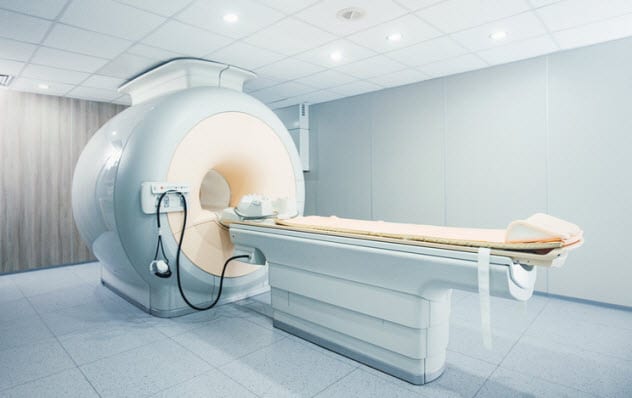
Liquid helium is a vital component for operating magnetic resonance imaging (MRI) scanners—the non-intrusive imaging technology that allows medical professionals to see inside patients’ bodies. Coils of metal wire inside the scanner are doused repeatedly in the ultracold fluid to minimize their electrical resistance. These wires generate a strong magnetic field up to 40,000 times greater than the field of the Earth.
There is a problem with this current setup: We are running low on helium. The substance is in worryingly short supply with no known way to manufacture any more. The average scanner requires 1,700 liters (449 gal) of liquid helium to cool the magnetic coils to a chilling -269 degrees Celsius (-452 °F).[2]
8 Bose-Einstein Condensates
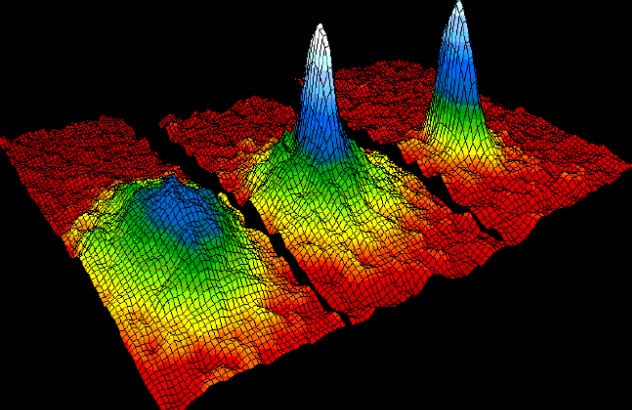
Low temperatures can cause some seriously strange behavior in gases. Typically, the atoms in a gas are constantly moving—whizzing around at high speed, bouncing off the walls of the container, and colliding with one another. If that gas is then heated up, the motion of the atoms will become even more energetic and frenetic.
However, when certain gases are cooled to extremely low temperatures—around -273 degrees Celsius (-460 °F)—the individual atoms start to drastically lose their energy. Eventually, when the atoms are unable to lose any more energy, they form an exotic type of matter known as a Bose-Einstein condensate (BEC).[3]
One of the most bizarre and brilliant properties of BECs is their ability to slow down and stop light. Danish physicist Lene Hau used this principle to slow down a laser beam from light speed to around 17 meters per second (56 ft/sec).
Hau and her team went on to develop a technique for storing individual pulses of light within BECs. These incredible breakthroughs could pave the way for new methods of data storage, particularly in quantum computers.
Although Albert Einstein and Satyendra Nath Bose first came up with the idea in the 1920s, it wasn’t until 70 years later that the first BEC was actually made. This was achieved in 1995 when American physicists Eric Cornell and Carl Wieman successfully cooled a gas of rubidium atoms to 170 nK—over a million times colder than outer space.
For their momentous contribution to scientific research, the pair—along with MIT professor Wolfgang Ketterle—was awarded the 2001 Nobel Prize in Physics.
7 Cryotherapy

Cryotherapy is a blanket term that refers to the use of low temperatures in medical treatments. More often than not, subzero chemicals are applied using a specialized cryoprobe to remove abnormal tissue cells. This includes everything from freezing off an unsightly wart to the destruction of a cancerous tumor.
Some proponents of cryotherapy claim that it has a plethora of other fantastical uses. They say that immersing yourself in a booth colder than -100 degrees Celsius (-148 °F) can prevent dementia, reduce depression, and even help you lose weight. But the evidence for this is spurious.[4]
6 Craters On The Moon
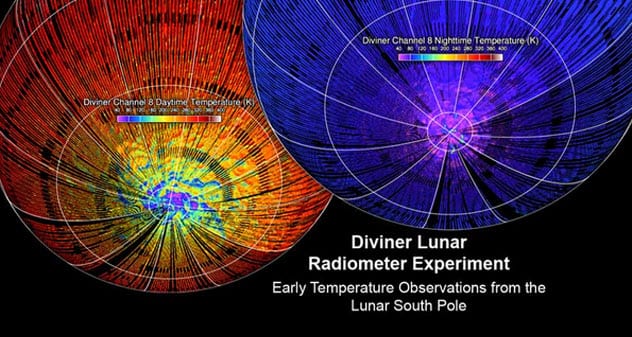
The coldest-known place in the solar system is a lot closer to home than you might imagine. It was originally believed to be the surface of Pluto. But in 2009, scientists discovered craters around the Moon’s south pole that can drop as low as -248 degrees Celsius (-414 °F) during winter. NASA’s Lunar Reconnaissance Orbiter made the discovery by measuring radiation levels from 50 kilometers (31 mi) above the Moon’s surface.
The coldest temperatures are found inside lunar crevices that are permanently cast in shadow, meaning they never receive any sunlight. These subzero craters act as “cold traps,” capturing elements and volatile gases that can be analyzed to map out an archive of activity on the Moon. For instance, minerals identified in Cabeus—a 98-kilometer (61 mi) crater close to the south pole—suggest a history of comet strikes.
That being said, the surface of the Moon is not always extremely cold. In fact, the temperature varies drastically depending on time and position. The equator around midday is so hot that it could boil water, whereas the poles are nearly as cold as liquid oxygen overnight.[5]
5 Liquid Nitrogen Ice Cream
Regular ice cream is made using specialized commercial freezers that churn milk, cream, and sugar together into a smooth, delicious blend. However, some producers like to do things a little differently. They have started to experiment by adding ultracold chemicals into the mix. Ice cream production can be a lengthy process, but by using liquid nitrogen, manufacturers can churn out batch after batch in a matter of minutes.
One of the key challenges for ice cream producers is to ensure that the mixture is frozen as quickly as possible. When liquids freeze over a long period of time, they form large jagged ice crystals. They can be incredible to view under a microscope but tend to spoil the texture of the ice cream.
However, rapid freezing with liquid nitrogen gives rise to much smaller crystals. This gives the ice cream that smooth, palatable consistency to really hit the spot.[6]
This eye-catching feat of science is finding enormous popularity in chic, specialist parlors and among boundary-pushing chefs. Ultrasmooth ice cream is whipped up in wisps of white mist and served to customers looking for that trendy, unorthodox experience. One parlor in Brooklyn even goes so far as to pour liquid nitrogen into its hot chocolate as well.
4 Liquid Nitrogen Cocktails
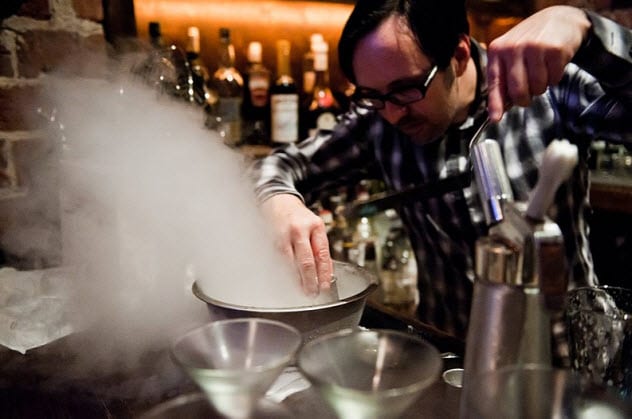
We’ve already explored the new trend for liquid nitrogen ice cream, but the culinary experiments aren’t limited to milky desserts. Liquid nitrogen, which is an incredible -196 degrees Celsius (-320 °F) in temperature, is being put to a multitude of good uses: cryo-blanching vegetables, grinding frozen herbs, splitting up berries into tiny icy droplets, and more.
Some bartenders have even gotten in on the act, pouring the subzero chemicals into their drinks for spellbinding effect. Liquid nitrogen cocktails produce a smoky white mist that hangs over the top of the glass, almost like a witch’s cauldron. They are proving a popular novelty treat among revelers.
However, these fashionable beverages aren’t without their potential risks.
In 2012, a British woman had to undergo surgery to remove part of her stomach after consuming the dangerous drink. Eighteen-year-old Gaby Scanlon needed a gastrectomy following a night out at Oscars bar in Lancaster when she effectively subjected her insides to frostbite.
The cryogenic cocktails came under heavy fire after the incident. The British Compressed Gases Association said that adding liquid nitrogen to a drink is an “extremely stupid” thing to do.[7]
3 Survival Of Resilient Animals
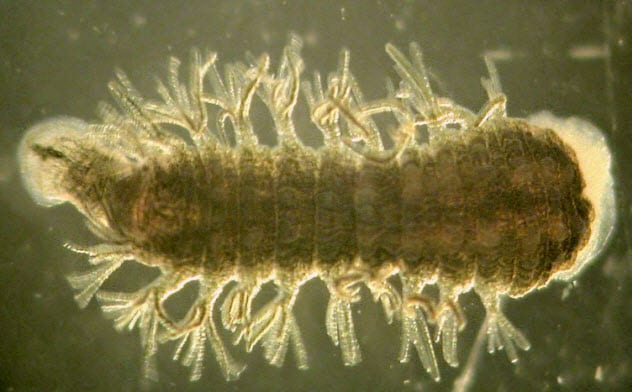
Subjected to extremely cold conditions, the vast majority of known creatures would barely stand a chance of survival, particularly warm-blooded mammals. For human beings, hypothermia begins to set in once our core body temperature dips below 35 degrees Celsius (95 °F). Your heart and other internal organs are no longer able to function properly. Extended exposure to the cold can cause them to shut down altogether.
However, there are a select few resilient little creatures that can survive temperatures unimaginable to us humans. The most impressive is a tiny parasitic leech from East Asia known as Ozobranchus jantseanus. Japanese researchers discovered that the leeches can withstand temperatures of around -196 degrees Celsius (-320 °F) for up to 24 hours.
There are only two other creatures that have previously survived those temperatures—water bears and drosophilid fly larvae. However, both species could only manage an hour.
Furthermore, a whole batch of leeches was able to survive a full nine months stored at -90 degrees Celsius (-130 °F)—only a few degrees above the lowest natural temperature ever measured on Earth. Some of them even managed 2.5 years.[8]
Scientists remain puzzled as to why this East Asian leech is so adaptable to extreme cold, especially as it would never usually encounter such temperatures in the wild. If they can find the answer, it could help improve cryopreservation techniques.
2 Serious Injuries
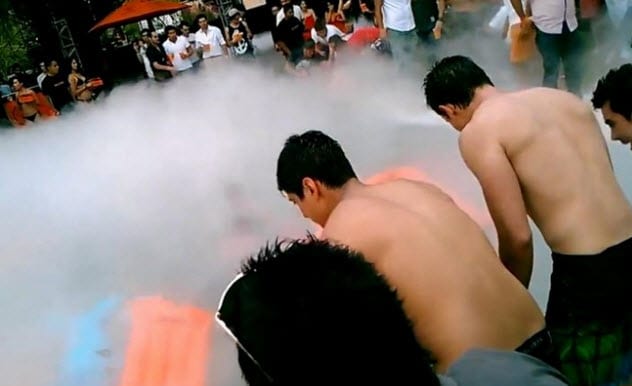
While a few creatures can survive for hours at temperatures well below zero, the vast majority of us find these low temperatures to be incredibly hazardous. You might think that the worst a short burst of severe cold can do is freeze your tongue to a lamppost. But at these extremes, even brief exposure can cause irreversible damage. For example, liquid nitrogen has the potential to freeze your skin tissue or eye fluid, which could lead to frostbite, eye damage, or even worse.
In fact, one particularly unwise use of liquid nitrogen put a man in a coma. In summer 2013, energy drink company Jagermeister decided to throw a promotional pool party in Leon, Mexico. To add to the atmosphere, the organizers wanted a mist to hang over the pool.
When liquid nitrogen boils, it produces an amazing cloud of nitrogen fog. So, instead of using fog machines, the organizers poured buckets and buckets of liquid nitrogen into the pool.[9]
The results were disastrous.
While the cryogenic chemicals definitely produced a lot of fog, they also hospitalized nine people. Instead of oxygen, swimmers started breathing in the clouds of nitrogen fog billowing over the pool and began to asphyxiate.
Paramedics had to pull people to safety after several swimmers passed out, including a 21-year-old man who fell into a coma. Fortunately, everyone injured at the party later recovered.
1 Absolute Zero

Of all the temperatures to be explored on this list, absolute zero is the coldest of them all. In fact, theoretically speaking, absolute zero is the lowest temperature possible. There is nothing colder. Particles in a gas at absolute zero would barely have an iota of energy. Their movement would purely be limited to miniscule fluctuations caused by quantum physics.
Absolute zero is such a remarkable temperature that scientists created a brand-new temperature scale in 1954 to properly address it. They named this scale Kelvin (K) in honor of the Irish physicist Lord Kelvin.
As the name suggests, absolute zero corresponds to zero Kelvin (0 K), which translates to -273.15 degrees Celsius (-459.67 °F). We already discussed temperatures a mere fraction of a degree above 0 K in the explanation of Bose-Einstein condensates.
Of course, it is worth mentioning that absolute zero is a purely theoretical temperature. The Third Law of Thermodynamics tells us that it would take an infinite amount of work to reach a temperature this low.[10]
That said, scientists experimenting with laser cooling techniques have managed to get remarkably close. In 2015, physicists at Stanford University cooled a cloud of rubidium atoms to 50 trillionths of a degree above 0 K, the all-time lowest temperature on record.
As these cutting-edge cooling techniques continue to evolve, breakthroughs in temperature-based research look set to keep on coming. At the turn of the 20th century, liquid nitrogen was a relatively new development. Now we have the technology to experiment at temperatures within a hair’s breadth of absolute zero. As for what the next 100 years have in store for us, only time will tell.
Read more interesting facts about temperatures on 10 Interesting Facts About Temperature and Top 10 Extreme Weather Anomalies.







